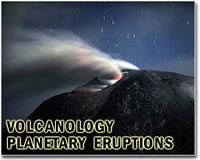| . |  |
. |
Banos, Ecuador (AFP) Dec 4, 2010 Authorities ordered the preventive evacuation Saturday in the southern Ecuadoran town of Bano as they put the country on high alert over a possible major eruption of the Tungurahua volcano. "People are coming to safe areas in an orderly fashion," Deputy Interior Minister Edwin Jarrin told AFP. The Geophysical Institute in Quito reported since early Saturday a "very rapid and sustained increase in seismic activity and other manifestations at the surface" of the volcano. Tungurahua, which has been erupting off and on since 1999, was spewing out incandescent material and ash, according to the institute. A red alert was in effect in Banos and other Andean villages of the 5,029-meter (16,500-foot) volcano, whose name means "throat of fire" in the local Quechua language. It is located some 135 kilometers (85 miles) south of Quito. In 1999, the 15,000 inhabitants of this town were forcibly evacuated by a powerful eruption and were unable to return to their homes for a year. Banos, one of the gateways to the Amazon jungle, hosts an average of a million tourists a year, 40 percent of them foreigners, according to local officials. Tungurahua's biggest eruption, in August 2006, left six people dead and destroyed hundreds of homes.
earlier related report "The decision was taken this morning at 9:00 am (0200GMT) as its eruption activities continue to slow down," the head of the volcanology office, Subandrio, told AFP from a monitoring office in Yogyakarta, the main city south of Merapi. He said that more than 250,000 people who had been living in evacuation shelters were now allowed to return home, except for those who lived in the worst affected district, Sleman, on the southern slope. "The volcano's threat is now limited to only some parts on the southern slope. People are not allowed to do activities there." Another volcanologist, Surono, said people must remain away from river banks due to possible fast-moving volcanic mudflow streaming down the volcano's slope during heavy downpours. "It's especially during the heavy rainfall as the eruptions left an estimated 150 million cubic metres of volcanic material on the slopes," he said. Hundreds of people fled their houses earlier this week when heavy rainfall flushed thousands of tons of volcanic material into several rivers, damaging a bridge and submerging houses. Disaster management officials said they had recorded 353 people killed. Many were buried under fast-flowing torrents of boiling hot gas and rock that incinerated villages on the southern slopes when the volcano exploded on November 5, its biggest eruption in over a century. The volcano, located on the central island of Java, killed around 1,300 people in 1930 but experts say the latest eruptions are its biggest since 1872.
Share This Article With Planet Earth
Related Links Bringing Order To A World Of Disasters When the Earth Quakes A world of storm and tempest
 Indonesia downgrades Mount Merapi volcano alert
Indonesia downgrades Mount Merapi volcano alertYogyakarta (AFP) Dec 3, 2010 Indonesian scientists Friday downgraded the alert status of Mount Merapi from its highest level after it killed more than 350 people in a series of violent eruptions that started in late October. "The decision was taken this morning at 9:00 am (0200GMT) as its eruption activities continue to slow down," the head of the volcanology office, Subandrio, told AFP from a monitoring office in Yogya ... read more |
|
| The content herein, unless otherwise known to be public domain, are Copyright 1995-2010 - SpaceDaily. AFP and UPI Wire Stories are copyright Agence France-Presse and United Press International. ESA Portal Reports are copyright European Space Agency. All NASA sourced material is public domain. Additional copyrights may apply in whole or part to other bona fide parties. Advertising does not imply endorsement,agreement or approval of any opinions, statements or information provided by SpaceDaily on any Web page published or hosted by SpaceDaily. Privacy Statement |